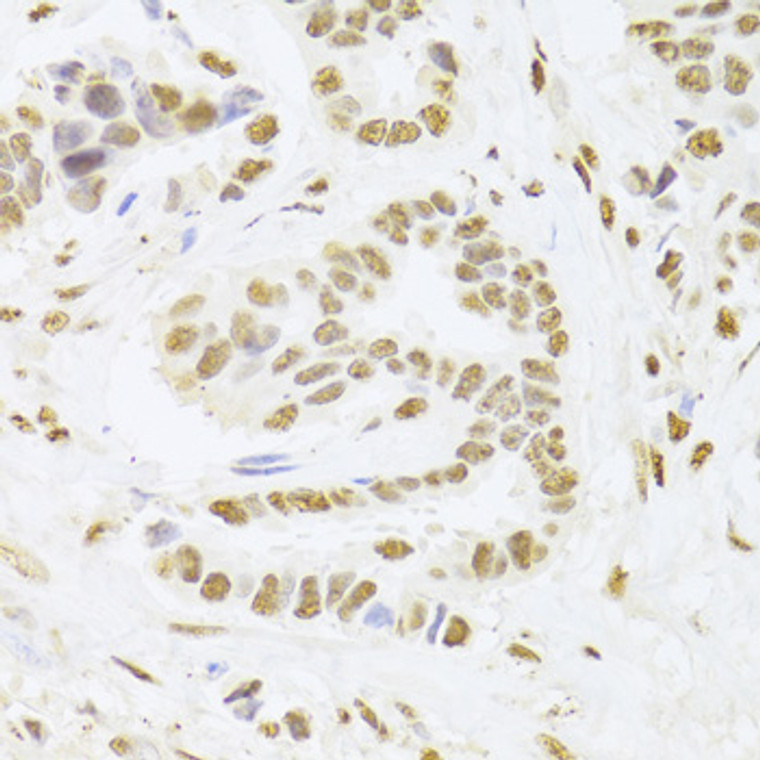| Host: |
Rabbit |
| Applications: |
WB/IHC-P/ELISA |
| Reactivity: |
Human/Mouse/Rat |
| Note: |
STRICTLY FOR FURTHER SCIENTIFIC RESEARCH USE ONLY (RUO). MUST NOT TO BE USED IN DIAGNOSTIC OR THERAPEUTIC APPLICATIONS. |
| Clonality: |
Polyclonal |
| Conjugation: |
Unconjugated |
| Isotype: |
IgG |
| Formulation: |
PBS with 0.02% Sodium Azide, 50% Glycerol, pH 7.3. |
| Purification: |
Affinity purification |
| Concentration: |
Lot specific |
| Dilution Range: |
WB:1:500-1:2000IHC-P:1:50-1:200ELISA:Recommended starting concentration is 1 Mu g/mL. Please optimize the concentration based on your specific assay requirements. |
| Storage Instruction: |
Store at-20°C for up to 1 year from the date of receipt, and avoid repeat freeze-thaw cycles. |
| Gene Symbol: |
ANP32A |
| Gene ID: |
8125 |
| Uniprot ID: |
AN32A_HUMAN |
| Immunogen Region: |
1-170 |
| Specificity: |
Recombinant fusion protein containing a sequence corresponding to amino acids 1-170 of human ANP32A (NP_006296.1). |
| Immunogen Sequence: |
MEMGRRIHLELRNRTPSDVK ELVLDNSRSNEGKLEGLTDE FEELEFLSTINVGLTSIANL PKLNKLKKLELSDNRVSGGL EVLAEKCPNLTHLNLSGNKI KDLSTIEPLKKLENLKSLDL FNCEVTNLNDYRENVFKLLP QLTYLDGYDRDDKEAPDSDA EGYVEGLDDE |
| Tissue Specificity | Expressed in all tissues tested. Highly expressed in kidney and skeletal muscle, moderate levels of expression in brain, placenta and pancreas, and weakly expressed in lung. Found in all regions of the brain examined (amygdala, caudate nucleus, corpus callosum, hippocampus and thalamus), with highest levels in amygdala. |
| Post Translational Modifications | Phosphorylated on serine residues, at least in part by casein kinase 2/CK2. The N-terminus is blocked. Some glutamate residues are glycylated by TTLL8. This modification occurs exclusively on glutamate residues and results in a glycine chain on the gamma-carboxyl group. |
| Function | Multifunctional protein that is involved in the regulation of many processes including tumor suppression, apoptosis, cell cycle progression or transcription. Promotes apoptosis by favouring the activation of caspase-9/CASP9 and allowing apoptosome formation. In addition, plays a role in the modulation of histone acetylation and transcription as part of the INHAT (inhibitor of histone acetyltransferases) complex. Inhibits the histone-acetyltranferase activity of EP300/CREBBP (CREB-binding protein) and EP300/CREBBP-associated factor by histone masking. Preferentially binds to unmodified histone H3 and sterically inhibiting its acetylation and phosphorylation leading to cell growth inhibition. Participates in other biochemical processes such as regulation of mRNA nuclear-to-cytoplasmic translocation and stability by its association with ELAVL1 (Hu-antigen R). Plays a role in E4F1-mediated transcriptional repression as well as inhibition of protein phosphatase 2A. (Microbial infection) Plays an essential role in influenza A, B and C viral genome replication. Mechanistically, mediates the assembly of the viral replicase asymmetric dimers composed of PB1, PB2 and PA via its N-terminal region. Also plays an essential role in foamy virus mRNA export from the nucleus. |
| Protein Name | Acidic Leucine-Rich Nuclear Phosphoprotein 32 Family Member AAcidic Nuclear Phosphoprotein Pp32Pp32Leucine-Rich Acidic Nuclear ProteinLanpMapmodulinPotent Heat-Stable Protein Phosphatase 2a Inhibitor I1pp2aPutative Hla-Dr-Associated Protein IPhapi |
| Database Links | Reactome: R-HSA-450520 |
| Cellular Localisation | NucleusCytoplasmEndoplasmic ReticulumTranslocates To The Cytoplasm During The Process Of NeuritogenesisShuttles Between Nucleus And Cytoplasm |
| Alternative Antibody Names | Anti-Acidic Leucine-Rich Nuclear Phosphoprotein 32 Family Member A antibodyAnti-Acidic Nuclear Phosphoprotein Pp32 antibodyAnti-Pp32 antibodyAnti-Leucine-Rich Acidic Nuclear Protein antibodyAnti-Lanp antibodyAnti-Mapmodulin antibodyAnti-Potent Heat-Stable Protein Phosphatase 2a Inhibitor I1pp2a antibodyAnti-Putative Hla-Dr-Associated Protein I antibodyAnti-Phapi antibodyAnti-ANP32A antibodyAnti-C15orf1 antibodyAnti-LANP antibodyAnti-MAPM antibodyAnti-PHAP1 antibody |
Information sourced from Uniprot.org
12 months for antibodies. 6 months for ELISA Kits. Please see website T&Cs for further guidance










